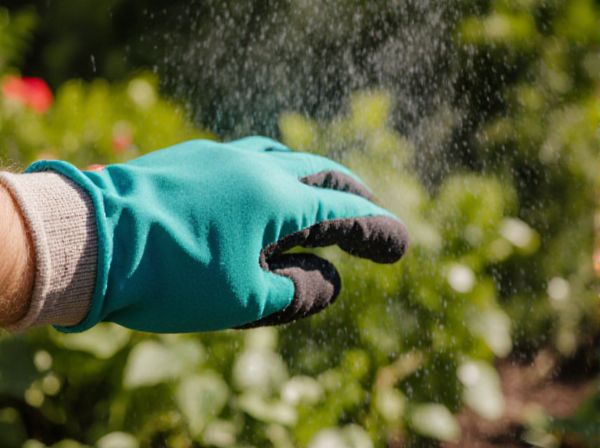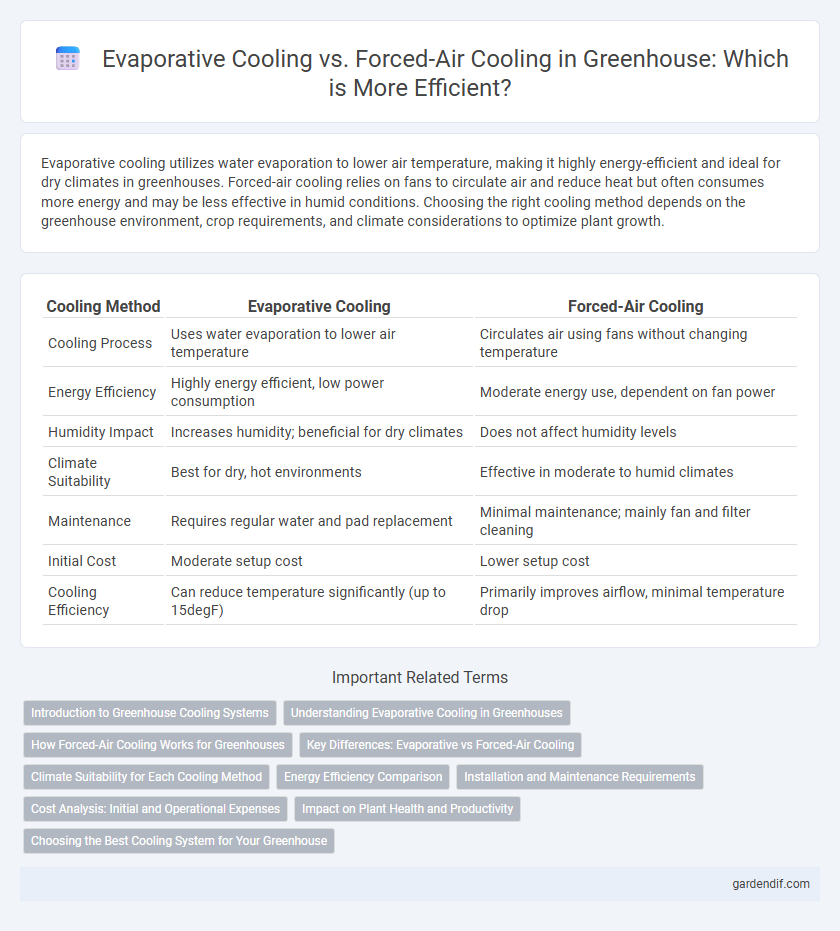
Evaporative cooling vs forced-air cooling Illustration
Evaporative cooling utilizes water evaporation to lower air temperature, making it highly energy-efficient and ideal for dry climates in greenhouses. Forced-air cooling relies on fans to circulate air and reduce heat but often consumes more energy and may be less effective in humid conditions. Choosing the right cooling method depends on the greenhouse environment, crop requirements, and climate considerations to optimize plant growth.
Table of Comparison
| Cooling Method | Evaporative Cooling | Forced-Air Cooling |
|---|---|---|
| Cooling Process | Uses water evaporation to lower air temperature | Circulates air using fans without changing temperature |
| Energy Efficiency | Highly energy efficient, low power consumption | Moderate energy use, dependent on fan power |
| Humidity Impact | Increases humidity; beneficial for dry climates | Does not affect humidity levels |
| Climate Suitability | Best for dry, hot environments | Effective in moderate to humid climates |
| Maintenance | Requires regular water and pad replacement | Minimal maintenance; mainly fan and filter cleaning |
| Initial Cost | Moderate setup cost | Lower setup cost |
| Cooling Efficiency | Can reduce temperature significantly (up to 15degF) | Primarily improves airflow, minimal temperature drop |
Introduction to Greenhouse Cooling Systems
Evaporative cooling in greenhouses uses water evaporation to lower air temperature, enhancing humidity and plant transpiration for optimal growth. Forced-air cooling relies on fans to circulate air, reducing heat by exchanging warm indoor air with cooler outside air. Both systems are essential for maintaining stable microclimates, improving photosynthesis efficiency and crop yield in controlled agricultural environments.
Understanding Evaporative Cooling in Greenhouses
Evaporative cooling in greenhouses relies on the natural process of water evaporation to lower air temperature, maintaining optimal humidity levels for plant growth. This method uses wet pads and fans to draw warm air through moist surfaces, effectively reducing heat through latent heat absorption, which is energy-efficient compared to forced-air cooling. Unlike forced-air systems that simply circulate air, evaporative cooling actively lowers temperature while improving air quality and moisture content, crucial for maximizing photosynthesis and crop yield.
How Forced-Air Cooling Works for Greenhouses
Forced-air cooling in greenhouses operates by circulating air through a network of fans and vents, creating a continuous airflow that removes heat and reduces humidity. This method promotes even temperature distribution, preventing hotspots and ensuring optimal plant growth conditions. The system's efficiency depends on proper fan placement, adequate vent sizing, and controlled airflow rates tailored to the greenhouse size and crop type.
Key Differences: Evaporative vs Forced-Air Cooling
Evaporative cooling uses water evaporation to lower air temperature and increase humidity, making it ideal for dry climates. Forced-air cooling relies on mechanical fans to circulate cooled or conditioned air, suitable for various environments but often less energy-efficient. Key differences include energy consumption, humidity impact, and effectiveness based on climate conditions, with evaporative systems being more eco-friendly and forced-air systems offering more precise temperature control.
Climate Suitability for Each Cooling Method
Evaporative cooling excels in hot, dry climates by utilizing water evaporation to lower air temperature and increase humidity, making it ideal for arid regions with low humidity levels. Forced-air cooling is more suitable for humid climates where evaporative methods are less effective, as it circulates cooled or conditioned air to maintain optimal greenhouse temperatures. Selecting the appropriate cooling method depends on climate parameters such as temperature, humidity, and local weather patterns to maximize plant growth and energy efficiency.
Energy Efficiency Comparison
Evaporative cooling in greenhouses consumes significantly less energy compared to forced-air cooling by utilizing water evaporation to reduce air temperature rather than relying on electrically powered fans or compressors. This method can reduce electricity usage by up to 90%, making it far more energy-efficient and environmentally sustainable for greenhouse climate control. Forced-air cooling systems, while effective in temperature regulation, typically require continuous power input, increasing operational costs and carbon footprint.
Installation and Maintenance Requirements
Evaporative cooling systems require installation near water sources with proper ventilation to ensure efficient airflow and humidity control, while forced-air cooling demands ductwork and electrical connections for fan operation. Maintenance of evaporative coolers involves regular water replacement, pad cleaning, and seasonal winterization to prevent mold and mineral buildup. Forced-air cooling systems need periodic filter changes, duct cleaning, and inspection of mechanical components to maintain air quality and system performance.
Cost Analysis: Initial and Operational Expenses
Evaporative cooling systems in greenhouses generally have lower initial installation costs compared to forced-air cooling units due to simpler technology and fewer mechanical components. Operational expenses for evaporative coolers are significantly reduced by lower energy consumption, as they primarily use water evaporation rather than electric fans or compressors. However, maintenance costs for evaporative systems include water treatment and regular pad replacement, while forced-air systems may incur higher electricity bills and more frequent mechanical repairs.
Impact on Plant Health and Productivity
Evaporative cooling in greenhouses enhances plant health by maintaining optimal humidity levels and reducing heat stress, which boosts photosynthesis and growth rates. Forced-air cooling, while effective at lowering temperature rapidly, can cause fluctuations in humidity that may lead to plant dehydration and increased susceptibility to diseases. Choosing evaporative cooling systems results in more stable microclimates, promoting consistent productivity and improved crop quality.
Choosing the Best Cooling System for Your Greenhouse
Evaporative cooling systems excel in dry climates by reducing temperature through water evaporation, offering energy-efficient and natural humidity control ideal for plant health in greenhouses. Forced-air cooling relies on fans to circulate air, providing rapid temperature regulation and better ventilation, which is crucial in humid environments to prevent mold and mildew. Selecting the best cooling system depends on your local climate, greenhouse size, and specific crop requirements to maintain optimal growing conditions.
Evaporative cooling vs forced-air cooling Infographic

 gardendif.com
gardendif.com